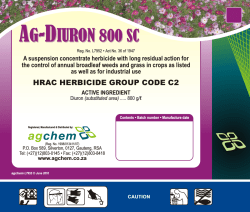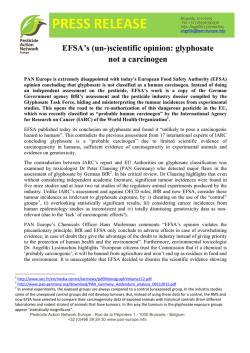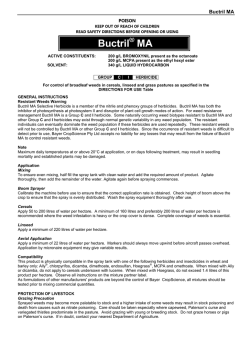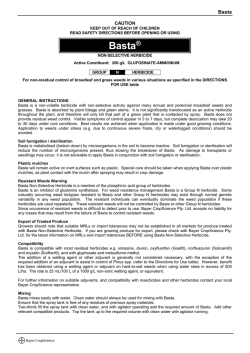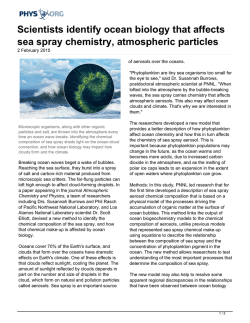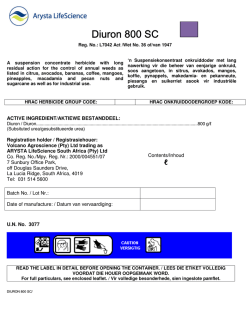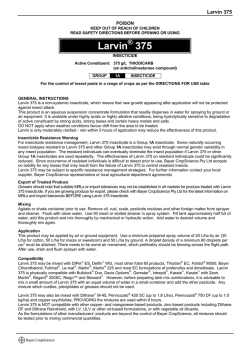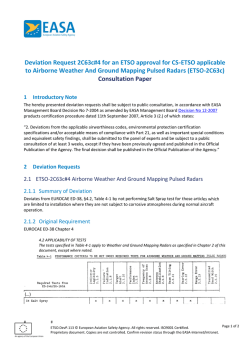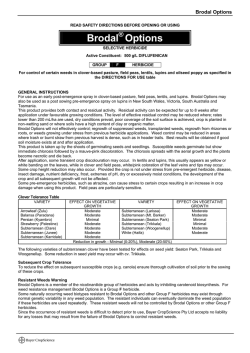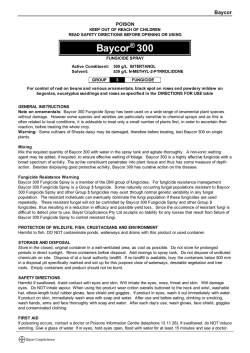
Text - General Information
GENERAL INFORMATION Refer to web version of the ND Weed Control Guide at: www.ndsu.edu/weeds for additional general information: - Field investigation of crop injury - Herbicide + Insecticide/Fungicide/Fertilizer - Herbicide storage temperatures - Wick application - Backpack and hand-held sprayer application A1. PPI AND PRE HERBICIDES Incorporation of herbicides Good weed control with PPI and PRE herbicides depends on many factors, including rainfall after application, soil moisture, soil temperature, soil type and weed species. For these reasons, PRE herbicides applied to the soil surface sometimes fail to control weeds. Herbicides that are incorporated into the soil surface usually require less rainfall after application for effective weed control than unincorporated herbicides. A rotary hoe or harrow will activate PRE herbicides under dry conditions and control small weeds emerging through a PRE herbicide. Many factors influence the activity and performance of soil-applied herbicides. Factors that should be considered are: rate too low for soil type, high weed pressure, weeds not listed on label, poor control in wheel tracks, cloddy soil, wet soil, amount of previous crop residue, dry weather, poor incorporation, improper setting of incorporation implement, herbicide resistant weeds, incorporation too shallow or deep, incorporation speed too slow, worn sweeps on cultivator, single pass instead of two pass incorporation, and second incorporation deeper than first. Consider these possibilities before poor weed control is attributed only to the herbicide. Buckle, Eptam, Far-Go, Ro-Neet, Sonalan, and Treflan* require incorporation. Eptam, Far-Go, and Ro-Neet must be incorporated immediately (within minutes) after application. Treflan incorporation may be delayed up to 24 hours if applied to a cool, dry soil and if wind velocity is less than 10 mph. Sonalan incorporation may be delayed up to 48 hours. Prowl* is labeled only PPI in soybean, dry beans, and pulse crops and labeled PRE, not PPI, on corn. Dual*, Harness/Surpass*, IntRRo*, and Outlook* may be used PRE but shallow PPI improves weed control, particularly on fine textured soils. Incorporation of Dual*, and Nortron* may be delayed several days. Incorporation of Eradicane and Eptam can be delayed up to 4 hours when applied with liquid fertilizer and the same day when impregnated on dry bulk fertilizer. Ro-Neet can be incorporated up to 4 hours after application and up to 8 hours when impregnated on dry fertilizer. Perform a second tillage at right angles to the initial incorporation if a disk or field cultivator is used. The second incorporation will incorporate any herbicide remaining on the soil surface and provide more uniform distribution in the soil, thereby improving weed control and reducing crop injury. A2. SOIL ORGANIC MATTER TEST Soil-applied herbicides are adsorbed and inactivated by soil constituents in the following order: organic matter>clay>silt>sand. Adjust herbicide rates for soil type and organic matter content. Most soil-applied herbicides require higher rates to be effective in high organic matter soils, but crop safety may be marginal on low organic matter soils. Linuron activity requires low organic matter. Far-Go, Treflan* and most POST herbicides are affected only slightly by organic matter levels. Organic matter levels should be determined on each field where organic-matter-sensitive herbicides are to be used. Organic matter levels change very slowly, and testing once every 5 years should be adequate. A3. POST APPLIED HERBICIDES Weed control from POST herbicides is influenced by rate, weed species, weed size, and climatic conditions. Labeled rates will be effective under favorable conditions and when weeds are small and actively growing. Use the highest labeled rates under adverse conditions and for well established weeds. Sunlight inactivates some herbicides by the ultraviolet (UV) spectrum of light. Treflan* and Eptam degradation is minimal when incorporated soon after application. “Dim” herbicides (Achieve, Select*, and Poast) are highly susceptible to UV light and will degrade rapidly if left in nonmetal spray tanks for an extended period of time or if applied during mid-day. To avoid UV breakdown, apply soon after mixing and add an effective oil adjuvant which speeds absorption. Ideal temperatures for applying most POST herbicides are between 65 and 85 F. Speed of kill may be slow when temperatures remain below 60 F. Some herbicides may injure crops if applied above 85 F or below 40 F. Avoid applying volatile herbicides under conditions where vapors and particle drift may injure susceptible crops, shelterbelt trees, or farmsteads. Temperatures following herbicide application influence crop safety and weed control. Crops metabolize herbicides but metabolism slows during cool or cold conditions, which extends the amount of time required for plants to degrade herbicides. Rapid degradation under warm conditions allow plants to escape herbicide injury. Herbicides may be sprayed following cold night-time temperatures if day-time temperatures warm to at least 60 degrees. Some “Fop” ACCase herbicides (fenoxaprop) are more effective during cold/cool temperatures and are much less effective when grass weeds are drought stressed. Other ACCase herbicides, such as Assure II*, Poast, and Select* control grasses best in warm weather when grasses are actively growing. ALS grass herbicides in wheat generally provide more consistent and greater grass control in warm, dry conditions compared with cool, wet conditions. Cool or cold conditions at or following application of ACCase herbicides may increase injury to wheat. Wild oat is a cool season grass but green and yellow foxtail are warm season grasses and may stop growing under cold conditions, resulting in poor control. Weeds are controlled most effectively when plants are actively growing. Cold temperatures and freezing conditions following application of ALS herbicides, Buctril*, and metribuzin may increase crop injury with little effect on weed control. Delay applying fenoxaprop, ALS herbicides, and metribuzin until daytime temperatures exceed 60F and after active plant growth resumes. Basagran*, Cobra, Flexstar, Liberty, Ignite, paraquat*, Reflex, and Ultra Blazer are less likely to cause crop injury when cold temperatures follow application but less weed control may result. 2,4-D, MCPA, Banvel*, Starane*, Stinger*, and glyphosate (resistant crops) have adequate crop safety and provide similar weed control across a wide range of temperatures, but weed death is slowed when cold temperatures follow application. Dew may increase absorption and weed control by hydrating leaf cuticle but may reduce weed control if spray run-off occurs. Rainfall shortly after POST herbicide application reduces weed control because herbicide is washed off the leaves before absorption is complete (See the rainfast interval chart on the next page). *Or generic equivalent. *Or generic equivalent. 70 A4. ROUNDUP / GLYPHOSATE 1. Use full rates that will kill weeds. Commercial glyphosate formulations contains 3 to 5 lbs acid equivalent (4 to 6.1 lb active ingredient) per gallon. Refer to the end of section A4 for rates based on formulation. Dead weeds do not produce seed or contribute to glyphosate resistance. Reduced glyphosate rates will amplify low-level resistance in weed progeny. Lambsquarters, waterhemp, horseweed (marestail), ragweed, and kochia have lowlevel resistance and require at least a full or elevated glyphosate rate. A reduced glyphosate rate may cause temporary injury symptoms allowing plants to recover, resume growth, and produce seed. Progeny from recovered plants will have a higher level of resistance and require higher herbicide rates to give the same level of control than parental plants. Surviving plants will contribute seed to the seed bank possessing amplified level of resistance. Refer to General Weed Management Guidelines in Section X1 - Herbicide Resistant Weeds. Minimum Interval Between Application and Rain for Maximum POST Weed Control. Herbicide Acuron Aim Alluvex Ally*/Escort* Armezon/Impact Assure II / Targa atrazine* Axial Star Axial XL Banvel* / Clarity* Basagran/bentazon* Betamix* Beyond Bronate*/Buctril* Cadet Callisto Callisto GT Capreno Cimarron X-tra* ClearMax Cobra Curtail* / M* Defol 750 DiFlexx diquat* Discover NG Engenia Enlist Duo Everest 2.0 / Sierra Express* Extreme Facet Fenoxaprop FirstRate Flexstar Flexstar GT 3.5 Foxfire Fusilade DX GoldSky Halex GT Harmony* Hornet / Stanza Huskie / Complete Instigate Laudis Laudis Flexx Liberty Lumax EZ Marvel MCPA amine *Or generic equivalent Time Intrvl. 4 hr 4 hr 6-8 hr 4 hr 1 hr 1 hr 4 hr 1 hr 0.5 hr 6-8 hr 4-8 hr 6 hr 1 hr 1 hr 4 hr 1 hr 6-8 hr 1 hr 4 hr 1 hr 0.5 hr 6-8 hr 24 hr 6-8 hr 0.5 hr 0.5 hr 6-8 hr 1 hr 1 hr 4 hr 1 hr 6 hr 1 hr 2 hr 1 hr 6-12 hr 1 hr 1 hr 4 hr 1 hr 4 hr 2 hr 1 hr 4 hr 4 hr 6-8 hr 4 hr 4 hr 1 hr 4-6 hr Herbicide MCPA ester Metribuzin Milestone Olympus Orion Osprey Panoflex paraquat* Permit Perspective Plateau Poast PowerFlex Pulsar Pursuit Raptor Raze Realm Q Redeem Reflex Reglone Remedy Require Q Resolve*/Q Resource Rimfire Max Roundup*(Full adjuvant) Roundup* (Partial adj.) Roundup* (No adjuvant) Select* / Max Sharpen Solstice Spartan Charge Starane*/ Flex Starane NXT* Status Stinger* SU herbicides Supremacy Tordon 22K Ultra Blazer UpBeet Varisto Varro Weedmaster* WideMatch* Wolverine 2,4-D amine 2,4-D ester Time Intrvl. 1 hr 6-8 hr 4 hr 4 hr 4 hr 4 hr 4 hr 0.5 hr 4 hr 6-8 hr 1 hr 1 hr 4 hr 4 hr 1 hr 1 hr 1 hr 4 hr 2 hr 1 hr 0.5 hr 6-8 hr 4 hr 4 hr 1 hr 4 hr 6-12 hr 6-12 hr 6-12 hr 1 hr 1 hr 4 hr 6-8 hr 4 hr 1 hr 4 hr 6-8 hr 4 hr 2 hr 6-8 hr 4 hr 6 hr 4 hr 4 hr 6-8 hr 6 hr 1 hr 4-8 hr 1 hr 2. Apply to small, actively growing annual plants. This early timing will not coincide with the preferred timing of early bud to early flower for most perennial weeds. Usually larger and older annual plants can be more difficult to control. 3. To optimize glyphosate phytotoxicity from sequential applications, delay the second application until new growth appears (>10-14 days). 4. Delay tillage at least 1 day after treating annual weeds and 3 days after treating perennial weeds for greater weed control from increased glyphosate absorption and translocation. 5. Low water volume (gpa) will enhance glyphosate activity. Low water volume produces spray droplets with high glyphosate concentration that results in greater absorption. Low spray volume also reduces the concentration of antagonistic salts in water that can interact with glyphosate. Low gpa produces small drops which may increase risk of damaging drift. 6. Glyphosate is very water soluble. High water solubility causes slow absorption through waxy plant cuticles. High air humidity increases glyphosate absorption and activity by hydrating leaf cuticle. Glyphosate activity also increases when plants are growing under good soil moisture. Inversely, weed control is reduced under low humidity and when weeds are drought stressed. 7. Always add reputable surfactant (NIS) to glyphosate unless prohibited by the label. Glyphosate absorption into plant tissue is slow and generally only 20-40% in most weed species. Add NIS at 1 qt/100 gal water to full adjuvant load formulations, 1 to 2 qt/100 gal water to partial adjuvant formulations, and 2 to 4 qt/100 gal water v/v to glyphosate formulations with no adjuvant. NIS may also increase retention of spray droplets and improve control of hard-to-wet species such as lambsquarters, and most grasses. Not all surfactants are equal - use reputable adjuvants. 8. Most oil adjuvants (COC) antagonize glyphosate - See #6. Most herbicides applied with glyphosate are lipophilic (oil soluble). These include Group 1, 2, 4, 5, 14, 15, and 27 herbicides (See X1). Oil adjuvants (COC and MSO) greatly enhance oil soluble herbicides but antagonize glyphosate. NIS + AMS enhance glyphosate phytotoxicity more than other additives, are less effective with oil soluble herbicides, and will only partially overcome oil adjuvant antagonism of glyphosate. MSO based ‘high surfactant oil concentrate’ adjuvants (HSMOC-see page 130) contain a higher concentration of surfactant than COC and MSO and enhance oil soluble herbicides without decreasing glyphosate activity. Most COC/petroleum based ‘high surfactant oil concentrate’ (HSPOC) adjuvants are inferior to HSMOC adjuvants and usually do not perform differently than common COC or petroleum oil adjuvants. 71 Glyphosate applied during cold weather, to large weeds, and weeds with low-level resistance will result in less weed control. AMS enhances weed control and can partially overcome reduced control of stressed plants. A4 - GLYPHOSATE 9. Apply oil adjuvants on an area basis (i.e. pt/A) rather than a volume basis (1% v/v/1 qt / 100 gal of water). HSMOC adjuvants are commercially recommended at half the POC and MSO rate (0.5% v/v vs 1% v/v). HSMOC adjuvants applied at full rates and on an area basis (1 to 1.5 pt/A) rather than on a volume basis (0.5% v/v spray water) will provide greater herbicide enhancement and more consistent weed control. HSMOC applied on a volume basis at low gpa does not contain enough oil adjuvant to optimize glyphosate and POST herbicides. Research data show wide temperature fluctuations (>15 F) 1 to 2 days before and after application are more likely to reduce weed control than consistently cool or cold temperatures. Wide temperature fluctuations can likely explain many situations where weed control is poor due to cold weather, especially with lambsquarters. 14. Excessive dew on plant foliage at application may reduce weed control by diluting the glyphosate concentration in spray droplets and negate the effect of low spray volume at application. Glyphosate absorption in plants is slow which partially explains the 6 to 12 hour rainfast period. Allow a 6 to 12 hour rainfast period for all glyphosate formulations regardless of label statements. Research has consistently shown increased glyphosate activity in humid conditions when leaf cuticles are hydrated. Dew on leaves will hydrate leaf cuticles and facilitate absorption. 10. Always add AMS to glyphosate. AMS enhances glyphosate absorption and translocation and deactivates antagonistic hard water salts (Na, Ca, Mg, Fe). As spray droplet water evaporates, sulfate from AMS binds with antagonistic salts and prevents binding with glyphosate. In addition, ammonium from AMS binds with glyphosate resulting in greater absorption and weed control. Nitrogen (ammonia) enhances glyphosate resulting in greater weed control in good and adverse growing conditions and even in the absence of antagonistic salts in water (See Section A6). AMS can be added at any time during spray tank loading when applying glyphosate but should be added first if applying several active ingredients in the tank with glyphosate. Allow granular AMS to dissolve before application or use a liquid formulation. 15. Glyphosate is not deactivated by sunlight. However, time of day application studies show that activity of glyphosate is greatest when applied in full sunlight after 10:00 am and before 6:00 pm. 16. Use drift management techniques. Glyphosate is a nonselective, non-residual, translocated, foliar herbicide. Glyphosate can cause severe injury or death of plants intercepting even a small amount of active ingredient in down-wind spray droplet drift. Several drift reducing nozzles (example, Turbo Tee-Jet) can reduce drift without reducing phytotoxicity. Do not use ‘thickener’ drift reducing adjuvants that negatively alter the spray pattern and reduce herbicide activity. 11. Glyphosate labels suggest AMS at 8.5 to 17 lb/100 gallons of water. However, analysis of water across the U.S. show 4 to 6 lbs/100 gal of AMS are adequate to overcome most hard water. Add AMS at a minimum of 1 lb/A if using greater than 12 gpa spray volume or 8.5 lb/100 gallons of water. The following equation can be used to calculate the amount of AMS needed to overcome antagonistic ions in the spray solution: lbs AMS/100 gal = (0.002 X ppm K) + (0.005 X ppm Na) + (0.009 X ppm Ca) + (0.014 X ppm Mg) + (0.042 X ppm Fe). The formula does not account for cationic minerals (Ca) on leaf surfaces (lambsquarters, sunflower, velvetleaf, others) that can antagonize glyphosate. Refer to A6. Water in Montana and western ND and SD can have hardness levels of 1600 to 2500 ppm and require AMS at 17 lb/100 gal water. Determine water quality to determine minimum AMS rate. If using adjuvants called “Water Conditioning”, or “AMS Replacement” adjuvants, use only those containing at least 4 lbs of AMS/100 gallons of water at their recommended rates. Data show generally less control from these AMS replacement adjuvants as compared to AMS at 8.5 lb/100 gal + NIS at 0.25% v/v. 17. Glyphosate is not volatile and does not produce fumes or vapor after application. Off-target movement of glyphosate from wind or during temperature inversions is in the form of droplets or particle drift, not volatility. 18. Tolerant plants escape phytotoxicity by metabolizing herbicides, except glyphosate. Plant metabolism slows during cool or cold conditions extending the amount of time required to degrade most herbicides. Plants do not metabolize glyphosate and absorbed glyphosate will remain in the plant until warm temperatures cause plants to resume translocation of glyphosate to growing points via the phloem. 12. Applying contact herbicides (Group 10, 14, and 22 - see X1) with glyphosate may result in antagonism and reduced weed control, especially of large weeds, winter-annual, biennial and perennial weeds. Contact herbicides cause rapid wilting and desiccation before the systemic glyphosate is absorbed reducing uptake and translocation within the plant. Contact herbicides may quickly kill small and susceptible weeds but regrowth of large weeds may be noticeable only a few days after application. Some contact herbicides that may antagonize glyphosate include: Aim, Cadet, Cobra, diquat, Fierce, Flexstar, Liberty, paraquat*, Phoenix, Reflex, Resource, Sharpen, Spartan, and Valor. High spray water volumes may overcome some antagonism. 19. Glyphosate can be applied in the fall after several frosts and will result in excellent control of annual, biennial, and perennial weeds. However, plant tissue must be green or purple and leaves firmly attached to the stem to absorb and translocate the herbicide. Do not apply glyphosate to desiccated plant tissue from low freezing temperatures. Fall application to new plant growth is required for optimum herbicide activity. 20. Glyphosate is deactivated by strong adsorption to soil (including dust) and organic matter. Slow absorption allows glyphosate on the plant leaf surface to be inactivated by dust present either on the leaf surface or transported by wind. This applies also to using slough or river water for spraying. The addition of NIS or AMS will not overcome inactivation. Placing nozzles before or after wheels may reduce inactivation from dust. Applying glyphosate perpendicular to the previous application or shifting the sprayer to one side of the previous path may also reduce inactivation by dust. 13. Cold weather is a stress to plants. Generally, weed control from glyphosate applied during or after cold weather may be the same as when applied in warm weather but the end result (weed control) may take longer. However, cold weather may decrease glyphosate activity on certain weeds. Ideal temperatures for applying POST herbicides are between 65 and 85 F. Speed of kill will be slower during cold weather. Use higher rates to overcome reduced control from cold temperatures before or after application. 72 21. Do not apply glyphosate brands formulated with surfactant (partial or full adjuvant formulations) to bodies of water because surfactant components are toxic to fish and aquatic life. Only noadjuvant formulations, such as Aquamaster, Rodeo, and some 4 lb ae/gal formulations of glyphosate can be applied to water. An approved NIS surfactant at 1 gal/100 gal water must be added to no-adjuvant glyphosate formulations for adequate weed control. Refer to the Adjuvant Section, on page 126 for a list of NIS adjuvants registered for use in water. Partial List of Registered Glyphosate Products in ND: 22. Glyphosate has been reported to inhibit manganese (Mn) uptake in plants from soil. Glyphosate is a strong nutrient chelator and can immobilize micronutrients through enzyme inhibition and reduce micronutrient efficiency. These responses have only been seen in micronutrient deficient soils and can be managed by applying micronutrients as warranted by soil test analysis and fertilizer recommendation. 23. Glyphosate does not require low spray solution pH. Generally, efficacy of glyphosate is equal across normal water pH used for herbicide application. A theory has been promoted that at low spray solution pH, glyphosate and other weakly acidic herbicides would be more lipophillic (nonpolar) and more readily absorbed across nonpolar plant cuticles. Some adjuvants for glyphosate formulations lower pH but glyphosate is soluble at low pH and maintains efficacy. Adding acidifiers with the purpose of lowering the pH of spray solutions containing glyphosate is unjustified. Most AMS replacement adjuvants (see Adjuvant Compendium on page 126) used at 2 qt/100 gal water reduce spray solution pH which may prevent some binding of glyphosate with antagonistic minerals in spray water. However, they do not contain sulfate to bind with cationic minerals and do not contain ammonia which binds with glyphosate and is required for glyphosate optimization. “Acidic AMS Replacement” adjuvants (see page 126) contain AMADS or monocarbamide dihydrogen sulfate (urea + sulfuric acid), can reduce spray solution pH to ~2 to reduce cation antagonism, and can optimize glyphosate similar to AMS but only when applied at a minimum of 2 qt/100 gal water. Refer to #1 on page 128 “Understanding a water quality analysis report” for additional information on spray solution pH. 24. Potassium (K) salt formulations of glyphosate may negatively interact with dma (dimethyl amine) salt formulations of 2,4-D in the spray tank resulting in precipitation. Conditions that increase the risk of precipitation are application in low gpa, using cold water, and using high herbicide rates. This is an example of two dissimilar salts causing physical incompatibility and possibility of reduced weed control. Another example of negative herbicide salt interaction is grass antagonism from tank-mixing glyphosate-ipa (isopropyl amine) and 2,4-D-dma (dimethyl amine). Landmaster BW, a mixture glyphosate-ipa and 2,4-D-ipa avoided this antagonism buy containing the same salt (ipa) for both herbicides. Trade Name Manufacturer Abundit Accord Aquamaster Barbarian Max Buccaneer Buccaneer Plus Buccaneer 5 Cornerstn 5 Plus Credit / 41 Credit / 41 Extra Nfrm Credit/Extra Cleanfield 41% Cleanfield Dry Credit Xtreme Duramax Durango DMA Extra Credit 5 Glyfos Glyfos X-tra Glyphogan Glysort Glysort Plus Gly Star 5 Gly Star 5 Extra Gly Star Gold Gly ” Gold Extra Gly Star Original Gly Star Plus Helosate Plus Helosate 70 Honcho plus Mad Dog Mad Dog Plus Makaze Lajj Plus Rodeo RT 3 RU PowerMax RU/Private labels RU WeatherMax Showdown Strikeout Touchdown CT Touchdn HiTech Touchdown iQ Touchdown Total Traxion Dupont Dow Monsanto West Central Tenkoz Tenkoz Tenkoz Winfield Sol. NuFarm NuFarm NuFarm Mid-America Mid-America NuFarm Dow Dow NuFarm Cheminova Cheminova MANA Glysortia Glysortia Albaugh Albaugh Albaugh Albaugh Albaugh Albaugh Helm Agro Helm Agro Monsanto Loveland Loveland Loveland Northmoose Dow Monsanto Monsanto Various Monsanto Helena Syngenta Syngenta Syngenta Syngenta Syngenta Glyphosate salt lb ae/gal ipa ipa ipa ipa & K ipa ipa ipa ipa ipa ipa NH4 & K ipa NH4 ipa & K dma dma ipa ipa ipa ipa ipa ipa ipa ipa ipa ipa ipa ipa ipa ipa ipa ipa ipa ipa ipa ipa K K ipa K ipa + NH4 ipa K K (2(NH3) K K 3 4 4 4.5 3 3 3.7 4 3 3 1.65+1.35 3 80.6% 2.5 + 2 4 4 3.7 3 3 3 3 3 4 4 3 3 3 3 3 4.72 3 3 3 3 3 4 4.5 4.5 3 4.5 2.7 + 0.3 3 4.17 5 3 4.17 4.17 lb ai/gal Adjuvant Load* 4 5.4 5.4 5.83 4 4 5 5.4 4 4 1.8 + 1.6 4 88.8% 6 5.4 5.4 5 4 4 4 4 4 5.4 5.4 4 4 4 4 4 6.3 4 4 4 4 4 5.4 5.5 5.5 4 5.5 3.64 4 5.1 6.1 4 5.1 5.1 Full None None Full Partial Full Partial Full Partial Full Full Partial None Full Full Full Partial Partial Full Partial Partial Full None Partial Partial Full Partial Full Full Full Partial Partial Full Full Partial None Full Full Partial Full Full Partial Full None Full Full Partial *Unless prohibited add NIS to commercial glyphosate formulations as follows: Full adjuvant load = add NIS at 1 qt/100 gal water. Partial adjuvant load = add NIS at 1 to 2 qt/100 gal water. No adjuvant load = add NIS at 2 to 4 qt/100 gal water. Table. Actual glyphosate product rates based on acid equivalent (ae) and active ingredient (ai) formulation concentrations Refer to page 4 for more information. lb ae lb ai 0.75 ae 1.125 ae 1.5 ae 2.25 ae 3 ae ---------------------- fl oz/A ---------------------3 = 4 = 32 48 64 96 128 3.75 = 5 = 25.6 38.4 51.2 76.8 102.4 4 = 5.4 = 24 36 48 72 96 4.17 = 5.1 = 23 34.5 46 69 92.1 4.5 = 5.5 = 21.3 32 42.6 64 85 4.72 = 6.3 = 20.3 30.5 40.7 61 81.4 5 = 6.1 = 19.2 28.8 38.4 57.6 76.8 73 A5. SPRAY ADJUVANTS A6. SPRAY CARRIER WATER QUALITY Questions about adjuvant selection are common. In most states, adjuvants are not regulated by the EPA or any other regulatory agency allowing an unlimited number of adjuvant products. Adjuvants are composed of a wide range of ingredients which may or may not contribute to herbicide phytotoxicity. Results vary when comparing specific adjuvants, even within a class of adjuvants. POST herbicide effectiveness depends on spray droplet retention, deposition of the active ingredient, and herbicide absorption by weed foliage. Adjuvants and spray water quality (Paragraph A6) influence POST herbicide efficacy. Adjuvants are not needed with PRE herbicides unless weeds have emerged and labels include POST application. Minerals, clay, and organic matter in spray carrier water can reduce the effectiveness of herbicides. Clay inactivates paraquat, diquat, and glyphosate. Organic matter inactivates herbicides. Hard water cations or micronutrients such calcium, magnesium, manganese, sodium, and iron reduce efficacy of all weak-acid herbicides. Cations antagonize POST herbicides efficacy by complexing with the herbicide to form salts (e.g. glyphosate-Ca) that are not readily absorbed by plants. ND water often contains a combination of sodium, calcium, magnesium, and iron and these cations generally are additive in the antagonism of herbicides. Antagonistic minerals can inactivate the activity of most POST herbicides, including glyphosate, growth regulators (not esters), ACCase inhibitors, ALS inhibitors, HPPD inhibitors, and Liberty. Spray adjuvants generally consist of surfactants, oils and fertilizers. The most effective adjuvant will vary with each herbicide, and the need for an adjuvant will vary with environment, weeds, and herbicide used. Adjuvant use should follow label directions and be used with caution as they may influence crop safety and weed control. An adjuvant may increase weed control from one herbicide but not from another. Effective adjuvants will enhance herbicides and improve weed control especially under adverse conditions. When added to a spray solution, the the sulfate (SO42-) ion complexes with the hard-water cations (e.g. calcium sulfate), causing the salt to precipitate from solution. Ammonium (NH4+) ions bind with herbicide molecules and reduces herbicide interaction with the hard-water cations. This combined effect increases absorption and efficacy. Ammonium nitrogen increases effectiveness of weak-acid herbicides formulated as a salt even in the absence of antagonistic salts in the spray carrier. Labels of many POST herbicides recommend oil adjuvants at 1% v/v. At water volume of 15 or 20 gpa, 1% oil adjuvant will provide a minimum adjuvant concentration (1% v/v PO in 17 gpa = 1.4 pt/A). The optimum rate of a PO is 2 pt/A. ND surveys show common spray volumes are 10 gpa or lower. PO at 1% v/v in 8.5 gpa = 0.68 pt/A and does not provide an sufficient amount of oil adjuvant. Further, aerial applications at 5 gpa will also require a higher adjuvant concentration if PO is used at 1% v/v. Use at least 1 lb/A of AMS when spray volume is more than 12 gpa. The amount of AMS needed to overcome antagonistic ions in the spray solution can be determined as follows: Lbs AMS/100 gal = (0.002 X ppm K) + (0.005 X ppm Na) + (0.009 X ppm Ca) + (0.014 X ppm Mg) + (0.042 X ppm Fe). This does not account for antagonistic minerals on or in the leaf tissue in species like lambsquarters, sunflower, and velvetleaf which may require additional AMS. Some herbicide labels contain information on adjuvant rates for different spray volumes. To ensure sufficient adjuvant concentration add the oil adjuvant at 1% v/v but no less than 1.25 pt/A at all spray volumes. Surfactant at 0.25 to 1% v/v water is generally sufficient across spray water volumes. Hard-to-wet weeds (lambsquarters) will require a higher NIS concentration and surfactants that retain more droplets on plant foliage. Use spray grade AMS to prevent nozzle plugging. Commercial liquid solutions of AMS are available and contain approximately 3.4 lbs of AMS/gallon. For 8.5 lbs of AMS/100 gallons of water add 2.5 gallons of liquid AMS solution. Analysis of spray water sources can determine water quality effects on herbicide efficacy. Water samples can be tested at the NDSU Soil and Water Laboratory: USPS: NDSU Dept 7680, Fargo, ND 58108-6050, UPS and Physical Address: Waldron Hall 202, 1360 Bolley Dr. NDSU, Fargo, ND 58102. 701 231-7864. Analysis is approximately $25.00 to $29.00. The analysis may report salt levels in ppm or grains. To convert from grains to ppm, multiply by 17 (Example: 10 grains calcium X 17 = 170 ppm calcium). AMS at 2% (17 lb/100 gallons water) will overcome antagonism from the highest calcium and/or sodium concentrations in North Dakota water. However, AMS at 4 to 8 lb/100 gal is adequate for most North Dakota water. Iron is the most antagonistic to many herbicides but not abundant in ND water. For an expanded discussion on adjuvants go to the A5 in the electronic version of the ND Weed Control Guide: http://www.ag.ndsu.edu/weeds/weed-control-guides For an expanded discussion on spray quality go to the A6 in the electronic version of the ND Weed Control Guide: http://www.ag.ndsu.edu/weeds/weed-control-guides 74 A7. SPRAY AND VAPOR DRIFT Risk of off-target herbicide movement and injury to non-target plants depends on the susceptibility of the plant to the applied herbicide. 2,4-D, MCPA, dicamba, glyphosate, and ALS herbicides have the greatest potential for damaging non-target plants. A8. SPRAYER CLEANOUT Herbicides may adsorb to the spray tank, hoses, nozzles, screens, and filters requiring thorough cleaning. Adsorbed herbicide may remain tightly adsorbed in sprayers through water rinsing and even through several tank-loads of other herbicides. Then, an added tank-load of mixture including an oil adjuvant, nitrogen solution, or basic pH blend adjuvant may cause the herbicide to desorb, disperse into the spray solution, and damage susceptible crops. Highly active herbicide residues that persist in sprayers and cause crop injury include dicamba and ALS herbicides. Herbicides attached to all tank and sprayer components must be desorbed and the residue removed in a cleaning process. Sprayer cleanout procedures are given on herbicide labels and should be followed. The following procedure illustrating a thorough sprayer cleanup procedure is effective for most herbicides: Step 1. Drain tank and rinse tank with clean water. Spray rinse water through the spray boom for at least 5 minutes. Step 2. Fill the sprayer tank with clean water and label identified cleaning solution. Agitate for 15 minutes. Step 3. Allow solution to set for 8 hours. Step 4. Spray the cleaning solution through the booms. Step 5. Clean nozzles, screens, and filters. Rinse the sprayer to with water and spray rinsate through the booms. Wind velocity and direction: Apply when wind direction is away from susceptible plants, during low wind speed, and in the absence of temperature inversions. Boom height: Adjust boom as close to the target as possible while maintaining uniform spray coverage. Choose nozzles with a wide angle as opposed to narrow angle nozzles. Spray shields: Cones around nozzles reduce drift by 25 to 50% and spray shields that enclose the entire boom reduce drift by 50 to 85%. Spray shields should not be used as a substitute for other drift control techniques but as a supplement to drift reduction. Drift control: Reduce drift by increasing droplet size, reducing spray pressure, using drift reduction nozzles, adding drift reducing additives that do not increase spray viscosity, and orienting nozzles rearward on aircraft. Drift-reducing nozzles: Sprayer nozzles designed to reduce spray drift increase spray droplet size and reduce the number of small droplets (fines). Two primary types of drift-reducing nozzles have pre-orifice and air-induction (venturi) designs. Common types of cleaning solutions are chlorine bleach (lowers pH), ammonia (increases pH), and commercially formulated tank cleaners. Never mix chlorine bleach and ammonia as a dangerous gas will be released. Read herbicide label for recommended tank cleaning solutions and procedures. Herbicide formulation: Some herbicides have been formulated to reduce drift. Amine formulated herbicides are less volatile than ester formulations. 2,4-D is formulated as an acid, ester, and various amine salt (e.g. dimethyl amine (dma)). 2,4-D has been formulated as a choline salt for use in Enlist soybean and is the least volatile formulation. Likewise, dicamba has been formulated as a dma salt (Banvel) and a comparatively less volatile diglycol amine (dga) salt (Clarity). Dicamba has been formulated as a bis(3aminopropyl)methylamine (bapma) salt for use in RU Xtend soybean and is the least volatile formulation. SPRAYER CLEANING SOLUTIONS FOR HERBICIDES: Water: Command, Extreme, Roundup*, Lightning, Raptor, Dupont TotalSol SU formulations. Bleach: Laudis. Ammonia or commercial tank cleaner + water: 2,4-D, Accent, Ally*, Amber, Assure II, Banvel*, Basagran*, Beacon, Buctril*, Cadet, Callisto, Cimarron Xtra*, Classic, Cobra, Dual*, Extreme, FirstRate, Fusilade DX, Fusion, Glean*, Gramoxone*, Harmony DF*, Harness/Surpass*, Hornet, IntRRO*, Lightning, Option, paraquat*, Peak, Permit, Prowl*, Pursuit, Python, Raptor, Reflex, rimsulfuron DF*, Resource, Select*, Stinger*, Steadfast*, Surpass*, Targa*, thifensulfuron DF, tribenuron DF*, Treflan*, and Ultra Blazer. Detergent or commercial tank cleaner + water: Aim, atrazine*, Clarity*, Flexstar, Liberty 280, Marksman, Metribuzin*, Poast/Plus, Status, and Yukon. 2,4-D resistant (Enlist) soybean and dicamba resistant (RU Xtend) soybean have been developed with Best Management Practices (BMP) to reduce risk of off-target movement. These include course to ultra coarse droplet size, buffer zones to susceptible plants, low volatile herbicide formulations, low boom height, and wind speed between 3 and 10 mph. Use only low volatile herbicide formulations that have been registered on each crop technology. Soybean is approximately 100 times more susceptible to dicamba than 2,4-D. Off-target movement as well as proper tank clean-out are important factors to consider for soybean safety. A9. MIXING INSTRUCTIONS: Some herbicide labels list a specific mixing sequence. In absence of specific directions follow adding pesticide formulations to a tank partially filled with water follows the A.P.P.L.E.S. method: Agitate Powders soluble Powders dry Liquid flowables and suspensions Emulsifiable concentrates Solutions. Each ingredient must be uniformly mixed before adding the next component, e.g., a soluble powder must be completely dissolved before adding the next component. Adjuvants are added in the same sequence as pesticides, e.g., ammonium sulfate is a soluble powder, oil adjuvants are emulsifiable concentrates; and most surfactants are solutions. Within each group, usually add the pesticide before the adjuvant, e.g., a soluble-powder pesticide before ammonium sulfate. A proportion of the spray volume will be deposited on the soil surface. A dry soil surface will adsorb herbicide molecules. A rain or precipitation event can desorb herbicide molecules from soil particles and allow volatilization. Desorption can happen several weeks after application. We expect low volatile 2,4-D and dicamba formulations can also volatilize from soil. Refer to the following web sites for additional information: http://www.ag.ndsu.edu/smallgrains/presentations/2013-best-of-the -best-in-wheat-and-soybean/robinson http://www.ag.ndsu.edu/publications/landing-pages/crops/air-tempe rature-inversions-ae-1705 75
© Copyright 2026
